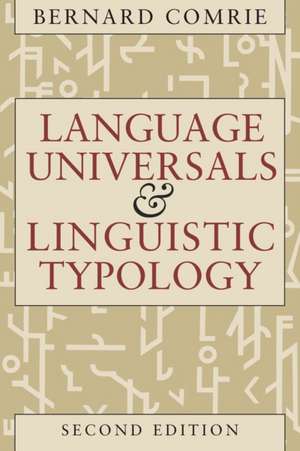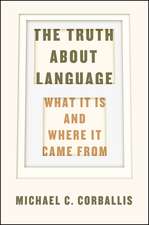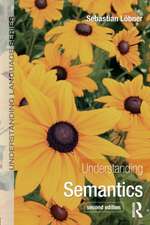Language Universals and Linguistic Typology: Syntax and Morphology
Autor Bernard Comrieen Limba Engleză Paperback – 30 iun 1989
Since its first publication, Language Universals and Linguistic Typology has become established as the leading introductory account of one of the most productive areas of linguistics—the analysis, comparison, and classification of the common features and forms of the organization of languages. Adopting an approach to the subject pioneered by Greenberg and others, Bernard Comrie is particularly concerned with syntactico-semantic universals, devoting chapters to word order, case making, relative clauses, and causative constructions. His book is informed throughout by the conviction that an exemplary account of universal properties of human language cannot restrict itself to purely formal aspects, nor focus on analysis of a single language. Rather, it must also consider language use, relate formal properties to testable claims about cognition and cognitive development, and treat data from a wide range of languages. This second edition has been revised and updated to take full account of new research in universals and typology in the past decade, and more generally to consider how the approach advocated here relates to recent advances in generative grammatical theory.
Preț: 288.42 lei
Nou
Puncte Express: 433
Preț estimativ în valută:
55.20€ • 57.02$ • 45.94£
55.20€ • 57.02$ • 45.94£
Carte tipărită la comandă
Livrare economică 25 martie-08 aprilie
Preluare comenzi: 021 569.72.76
Specificații
ISBN-13: 9780226114330
ISBN-10: 0226114333
Pagini: 275
Dimensiuni: 152 x 229 x 23 mm
Greutate: 0.36 kg
Ediția:Second Edition
Editura: University of Chicago Press
Colecția University of Chicago Press
ISBN-10: 0226114333
Pagini: 275
Dimensiuni: 152 x 229 x 23 mm
Greutate: 0.36 kg
Ediția:Second Edition
Editura: University of Chicago Press
Colecția University of Chicago Press
Notă biografică
Bernard Comrie is chair of the department of linguistics at the University of Southern California. He is the author of many publications including Aspect and Tense, and is editor of Studies in Language.
Cuprins
Preface to the second edition
Preface to the first edition
Preface to the second printing
I. Language Universals
1.1. Approaches to Language Universals
1.1.1. Two major approaches
1.1.2. The data base
1.1.3. Degrees of abstractness
1.2. Classification of Language Universals
1.2.1. Formal and substantive universals
1.2.2. Implicational and non-implicational universals
1.2.3. Absolute universals and tendencies
1.3. Explanations for Language Universals
1.3.1. Common genetic origin
1.3.2. External explanations
1.4. Summary
Notes and references
2. Language Typology
2.1. Typology and Universals
2.2. Typological Parameters
2.3. Morphological Typology
2.4. Some Further Typological Parameters
Notes and references
3. Theoretical Prerequisites
3.1. Semantic Roles
3.2. Pragmatic Roles
3.3. Grammatical Relations
3.4. Morphological Cases
3.5. Illustration: English and Russian Clause Structure
Notes and references
4. Word Order
4.1. Word Order Parameters
4.2. Correlations Among Word Order Parameters
4.2.1. Greenberg's correlations
4.2.2. Generalizations of Greenberg's results
4.2.3. Critique of the generalizations
4.3. The Value of Word Order Typology
Notes and references
5. Subject
5.1. The Problem
5.2. On Definitions and Categories
5.3. Ergativity
5.4. Semantic and Pragmatic Factors
Notes and references
6. Case Marking
6.1. The Discriminatory Function of Cases
6.2. Natural Information Flow in the Transitive Construction
6.2.1. Inverse forms
6.2.2. Differential marking of A and P
6.3. Summary
Notes and References
7. Relative Clauses
7.1. Some Typological Characteristics of English Relative Clauses
7.2. Types of Relative Clause
7.2.1. Defining the notion relative clause
7.2.2. Word order and relative clause types
7.2.3. The role of the head in the relative clause
7.2.4. The role of the head in the main clause
7.3. Accessibility to Relative Clause Formation
7.3.1. Simplex sentences
7.3.2. Complex constructions
7.3.3. The distribution of relative clause types
Notes and references
8. Causative Constructions
8.1. Parameters in the Study of Causative Constructions
8.1.1. Formal parameters
8.1.2. Semantic parameters
8.2. Valency Changes in Morphological Causatives
Notes and references
9. Animacy
9.1. Introduction: The Nature of Animacy
9.2. Phenomena Controlled by Animacy
9.3. Conceptual Animacy Distinctions
9.4. Conclusions: The Nature of Animacy
Notes and references
10. Typological and Historical Linguistics
10.1. Diachronic Dimensions in Universals and Typology
10.2. Areal Typology
10.3. Typology and Reconstruction
10.3.1. Word order typology
10.3.2. Word order and morpheme order
10.4. Typology and Diachronic Explanation
Notes and references
11. Conclusions and Prospects
Map showing location of languages cited
References
Index of languages
Index of proper names
Index of topics
Preface to the first edition
Preface to the second printing
I. Language Universals
1.1. Approaches to Language Universals
1.1.1. Two major approaches
1.1.2. The data base
1.1.3. Degrees of abstractness
1.2. Classification of Language Universals
1.2.1. Formal and substantive universals
1.2.2. Implicational and non-implicational universals
1.2.3. Absolute universals and tendencies
1.3. Explanations for Language Universals
1.3.1. Common genetic origin
1.3.2. External explanations
1.4. Summary
Notes and references
2. Language Typology
2.1. Typology and Universals
2.2. Typological Parameters
2.3. Morphological Typology
2.4. Some Further Typological Parameters
Notes and references
3. Theoretical Prerequisites
3.1. Semantic Roles
3.2. Pragmatic Roles
3.3. Grammatical Relations
3.4. Morphological Cases
3.5. Illustration: English and Russian Clause Structure
Notes and references
4. Word Order
4.1. Word Order Parameters
4.2. Correlations Among Word Order Parameters
4.2.1. Greenberg's correlations
4.2.2. Generalizations of Greenberg's results
4.2.3. Critique of the generalizations
4.3. The Value of Word Order Typology
Notes and references
5. Subject
5.1. The Problem
5.2. On Definitions and Categories
5.3. Ergativity
5.4. Semantic and Pragmatic Factors
Notes and references
6. Case Marking
6.1. The Discriminatory Function of Cases
6.2. Natural Information Flow in the Transitive Construction
6.2.1. Inverse forms
6.2.2. Differential marking of A and P
6.3. Summary
Notes and References
7. Relative Clauses
7.1. Some Typological Characteristics of English Relative Clauses
7.2. Types of Relative Clause
7.2.1. Defining the notion relative clause
7.2.2. Word order and relative clause types
7.2.3. The role of the head in the relative clause
7.2.4. The role of the head in the main clause
7.3. Accessibility to Relative Clause Formation
7.3.1. Simplex sentences
7.3.2. Complex constructions
7.3.3. The distribution of relative clause types
Notes and references
8. Causative Constructions
8.1. Parameters in the Study of Causative Constructions
8.1.1. Formal parameters
8.1.2. Semantic parameters
8.2. Valency Changes in Morphological Causatives
Notes and references
9. Animacy
9.1. Introduction: The Nature of Animacy
9.2. Phenomena Controlled by Animacy
9.3. Conceptual Animacy Distinctions
9.4. Conclusions: The Nature of Animacy
Notes and references
10. Typological and Historical Linguistics
10.1. Diachronic Dimensions in Universals and Typology
10.2. Areal Typology
10.3. Typology and Reconstruction
10.3.1. Word order typology
10.3.2. Word order and morpheme order
10.4. Typology and Diachronic Explanation
Notes and references
11. Conclusions and Prospects
Map showing location of languages cited
References
Index of languages
Index of proper names
Index of topics












